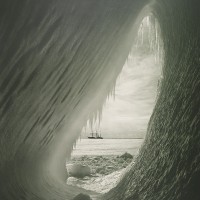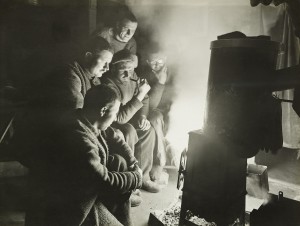
Whenever I think of Scott’s or Shackleton’s ill-fated Antarctic expeditions, I tend to be more preoccupied with Titus Oates being some time and 22 men being marooned on an island for four months. That both of these expeditions had official photographers who schlepped along tonnes of equipment, including whatever they needed to develop their images from glass plates, has sort of passed me by.
But Scott’s doomed Terra Nova expedition was accompanied by the first official polar expedition photographer, Herbert Ponting, and Frank Hurley was one of the 22 men stranded on Elephant Island when the Endurance was trapped and crushed by ice. Ponting was never meant to travel across the ice to the Pole and Hurley managed to salvage 120 plates, a pocket-sized camera and a few rolls of film before the Endurance was lost. So some, at least, of their pictures survive.
Ponting presented his images to George V, whilst a selection of Hurley’s work was given to George V by Shackleton. And the Royal Collection will be exhibiting them from 21 October 2011 to 12 April 2012.
Ponting’s pictures consist of the wildlife and icebergs that they encountered as they sailed from New Zealand to Antarctica, as well as scenes of life on board ship and even shots of Scott’s last birthday dinner in 1911.
Hurley did what I can only think of as totally crazy things – like climb the rigging and spend three days out on the ice watching as the Endurance broke up – to get his photographs. As if going on a polar expedition isn’t dedication enough to the cause of photography. But he was, of course, rewarded with some wonderful pictures.
The Heart of the Great Alone will show at the Queen’s Gallery, Buckingham Palace, from Friday 21 October 2011 to 12 April 2012. Tickets for adults are £7.50, more details available from the Royal Collections website.
(Featured image: Grotto in an iceberg, 5 January 1911 by Herbert Ponting. Both images courtesy of The Royal Collection © 2011, Her Majesty Queen Elizabeth II.)






